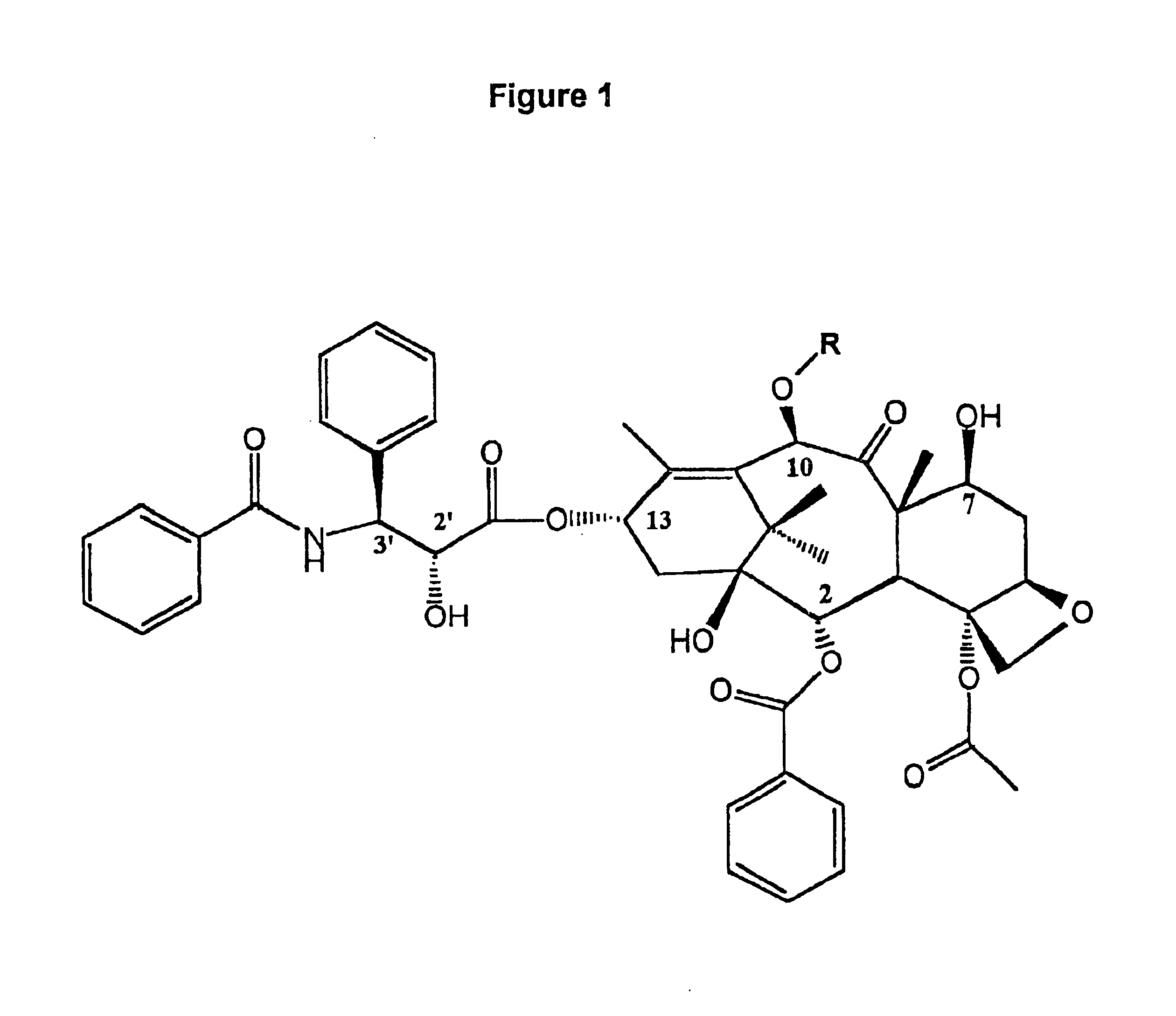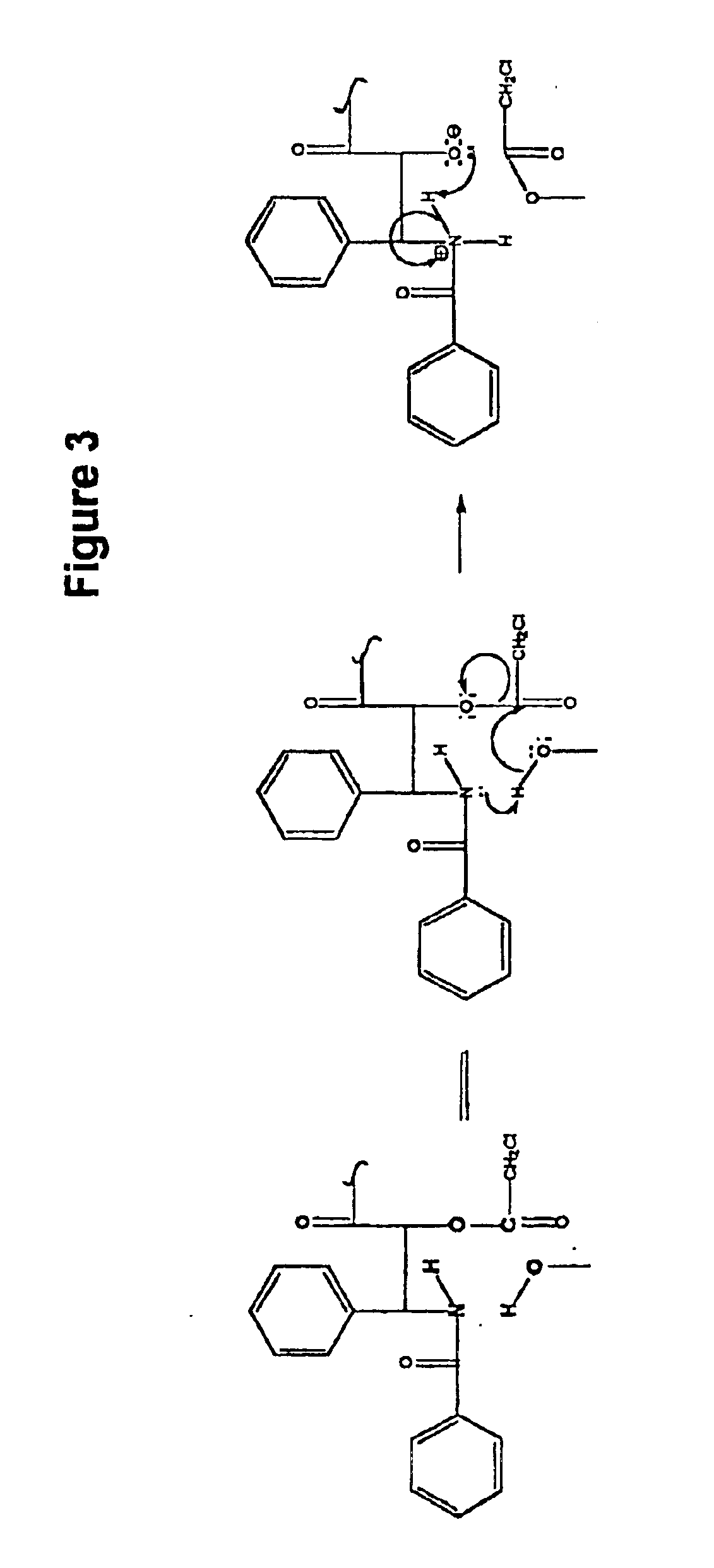Method for the selective removal of acyl-functionality attached to the 2'-hydroxy-group of paclitaxel-related derivatives
- Summary
- Abstract
- Description
- Claims
- Application Information
AI Technical Summary
Benefits of technology
Problems solved by technology
Method used
Image
Examples
example 1
Non-Aqueous, Ambient Temperature Conditions
2′,7-bis-Monochloroacetyl-10-deacetylpaclitaxel (2′,7-bis-CAC-DAP) (1). 3 10-Deacetylpaclitaxel (DAP) (81 mg, 0.10 mmol) and dimethylaminopyridine (DMAP) (5 mg) were dissolved in 1 mL of dimethylformamide (DMF) and a solution of monochloroacetic anhydride (43 mg, 0.25 mmol) in 5 mL dichloromethane (DCM) was added. The mixture was stirred at room temp. for 20 min. and 25 mL of DCM and 1 mL of water were added. The DCM solution was washed with 10 mL water, 10 mL sat. sodium bicarbonate, 10 mL water, and then dried over sodium sulfate. The DCM was evaporated and the residue dried over NaOH to provide 85 mg. of crude product. Analytical HPLC indicated two peaks having an area ratio of 2 to 1. The dried residue was dissolved in 1 mL of acetonitrile and loaded on a C18 Deltapack preparative column and eluted according to the general method. The effluent was fractionated and fractions corresponding to pure products were pooled. Yield: 43 mg (0.45 ...
example 2
Non-Aqueous, Elevated Temperature Conditions
7-Methoxyacetylpaclitaxel (7-MAC-PAC) (5). 2′,7-bis-MAC-PAC (30 mg, 0.03 mmol), prepared analogously to 1 and 3, was dissolved in 60 ml of methanol and the solution stirred at 47° C. Samples (20 μl) were withdrawn at several hour intervals and analyzed directly by HPLC. Nearly 90% conversion occurred within 7 hours. Solvent was evaporated and the residue purified by preparative HPLC. Overall yield: 22 mg (0.024 mmol, 80%) having 99% purity by HPLC; mp 132-136° C.; Analytical HPLC RT=19 min. (Suplecosil column); Elemental analysis calculated for C50 H55 NO16.H2O: C, 63.36%; H, 6.09%; N, 1.48%. Found: C, 63.95%; H, 6.35%; N, 1.35%. Characteristic proton NMR chemical shifts are provided in FIG. 5-Table 2
example 3
Aqueous Ethanol, Ambient Temperature Conditions
7-Monochloroacetyl-10-deacetylpaclitaxel (7-CAC-DAP) (2). 2′,7-bis-CAC-DAP (0.71 mg, 0.0007 mmol) was dissolved in 0.71 ml of 80% ethanol / 20% water and left at ambient temp. 20 μl samples were withdrawn at several hour intervals and analyzed directly by HPLC. Approximately 20% conversion occurred in 22 hours as quantitated by analytical HPLC (substrate RT=21 min. and product RT=16 min. using the Suplecosil column and elution protocol). The product was identified by HPLC comparison with an analytical sample of 7-CAC-DAP (Example 1).
PUM
 Login to View More
Login to View More Abstract
Description
Claims
Application Information
 Login to View More
Login to View More - R&D
- Intellectual Property
- Life Sciences
- Materials
- Tech Scout
- Unparalleled Data Quality
- Higher Quality Content
- 60% Fewer Hallucinations
Browse by: Latest US Patents, China's latest patents, Technical Efficacy Thesaurus, Application Domain, Technology Topic, Popular Technical Reports.
© 2025 PatSnap. All rights reserved.Legal|Privacy policy|Modern Slavery Act Transparency Statement|Sitemap|About US| Contact US: help@patsnap.com



